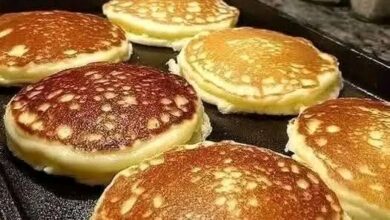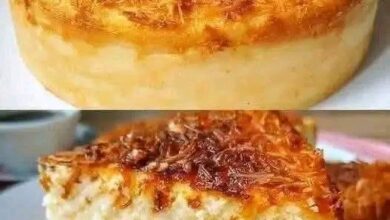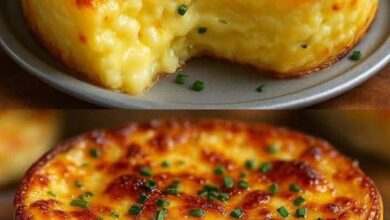classic Cream Cheese Cake (specifically a New York-Style Cheesecake)

Of course! Here is a comprehensive, “big” recipe for a classic Cream Cheese Cake (specifically a New York-Style Cheesecake), complete with all the elements you requested.
A Love Letter to New York-Sritua Cheesecake
The New York-style cheesecake is not merely a dessert; it is an institution. It stands apart from its lighter, fluffier cousins with an uncompromising identity: dense, incredibly rich, and devastatingly smooth. With a faint tang from cream cheese and a pure, sweet vanilla backdrop, each forkful is a testament to decadence. This is a cake that demands attention, best served in modest slices to be savored slowly. Baking it is a rite of passage for any serious home baker, and mastering it yields a reward that is worth every minute of patience.
Formation & History
The story of the modern cream cheese cake begins in the late 19th century with the invention of cream cheese itself. Dairymen in New York state, seeking to replicate the French cheese Neufchâtel, accidentally created a richer, creamier product. This new cheese, famously packaged by William Lawrence and later distributed by the Phenix Cheese Company (a precursor to Kraft), became the building block for a culinary icon.
While cheesecakes date back to ancient Greece, the “New York Style” was perfected in the 1900s. Jewish delicatessens in New York City, most notably Lindy’s and Junior’s, are credited with popularizing the version we know today. They increased the proportion of cream cheese, used a pure vanilla flavor, and often incorporated a sour cream topping, creating the uniquely dense, tall, and tangy cake that conquered the world.
Ingredients
For the Graham Cracker Crust:
· 1 ½ cups (150g) graham cracker crumbs
· ¼ cup (50g) granulated sugar
· 6 tablespoons (85g) unsalted butter, melted
· A pinch of salt
For the Cream Cheese Filling:
· 32 ounces (904g) full-fat cream cheese, at room temperature
· 1 ½ cups (300g) granulated sugar
· ¼ teaspoon fine sea salt
· 1 teaspoon pure vanilla extract
· ½ teaspoon fresh lemon juice (optional, enhances tang)
· 4 large eggs, at room temperature
· ⅔ cup (160ml) full-fat sour cream, at room temperature
· ⅔ cup (160ml) heavy whipping cream, at room temperature
For the Optional Sour Cream Topping:
· 1 ½ cups (345g) full-fat sour cream
· ⅓ cup (65g) granulated sugar
· 1 teaspoon pure vanilla extract
Methods & Instructions
Method 1: The Classic Water Bath (Bain-Marie)
This is the preferred method for professional results. It creates a gentle, steamy environment that cooks the cheesecake evenly without curdling the eggs or causing the top to crack.
Step-by-Step Instructions:
1. Prepare the Pan and Oven: Preheat your oven to 350°F (175°C). Wrap the outside of a 9-inch springform pan tightly with two layers of heavy-duty aluminum foil. This is crucial to prevent water from the bath seeping into the crust. Grease the inside of the pan lightly.
2. Make the Crust: In a medium bowl, mix the graham cracker crumbs, sugar, and salt. Pour in the melted butter and stir until the mixture resembles wet sand. Press the crumbs firmly and evenly into the bottom and about halfway up the sides of the prepared springform pan. Use the bottom of a flat glass or measuring cup to compact it.
3. Pre-bake the Crust: Bake the crust for 10 minutes. Remove and let it cool on a wire rack. Reduce the oven temperature to 325°F (160°C).
4. Start the Filling: In the bowl of a stand mixer fitted with a paddle attachment (or using a hand mixer), beat the cream cheese on medium-low speed until it is perfectly smooth and creamy, about 2-3 minutes. Scrape down the bowl and beater thoroughly. Lumps at this stage will remain in the final cake.
5. Incorporate Sugar and Flavor: Add the sugar and salt. Beat on low speed until fully combined, again scraping the bowl. Blend in the vanilla extract and lemon juice.
6. Add Eggs Gently: Add the eggs one at a time, beating on low speed just until the yolk disappears into the batter after each addition. Do not overmix after adding the eggs, as this incorporates too much air and can cause cracking.
7. Finish the Batter: Whisk the sour cream and heavy cream together in a liquid measuring cup. With the mixer on low, slowly pour this into the cream cheese mixture. Mix just until the batter is uniform and smooth. It should be thick, but pourable.
8. Assemble for Baking: Pour the filling into the cooled crust. Tap the pan firmly on the counter a few times to release any large air bubbles.
9. The Water Bath: Place the foil-wrapped springform pan into a large roasting pan. Place the roasting pan in the preheated oven on the center rack. Carefully pour hot (almost boiling) water into the roasting pan until it comes about halfway up the sides of the springform pan.
10. Bake: Bake for 1 hour and 30 to 1 hour and 45 minutes. The edges of the cake will look set, but the center (about a 4-inch diameter) will still jiggle slightly when you gently shake the pan. This is the sign of perfect doneness.
11. Turn Off the Oven: Turn off the oven, crack the oven door open with a wooden spoon, and let the cheesecake cool slowly in the oven for 1 hour. This gradual cooling is the second key to preventing cracks.
12. Apply Topping (if using): While the cake is in the oven, whisk together the sour cream, sugar, and vanilla for the topping. After the hour of cooling in the oven, spread the topping evenly over the slightly warm cake.
13. Cool Completely: Remove the cake (still in its pan) from the water bath and place it on a wire rack to cool to room temperature, about another 2 hours.
14. Chill: Once completely cool, cover the pan with plastic wrap and refrigerate for at least 8 hours, preferably 24 hours. This final step is non-negotiable; it allows the flavors to meld and the texture to firm up into the classic dense cream cheese cake.
Method 2: The Low-Temperature Bake (No Water Bath)
A simpler, yet still effective, method for those wary of the water bath. It relies on a very low oven temperature to cook the cake gently.
· Instructions: Follow steps 1-8 as above, but do not use a water bath. Instead, place a pan of hot water on the bottom rack of the oven to create steam. Bake the cheesecake at 300°F (150°C) for 1 hour 15 minutes to 1 hour 30 minutes, or until the edges are set and the center has a slight jiggle. Proceed with steps 11-14 for cooling and chilling.
Nutrition & Benefits
Let’s be clear: this is a celebratory indulgence. Its primary “benefit” is the immense joy and satisfaction it brings.
· Nutrition (Approximate per slice, 12 slices):
· Calories: ~650
· Fat: 45g
· Saturated Fat: 26g
· Carbohydrates: 55g
· Sugar: 45g
· Protein: 10g
· Calcium: Provides a significant amount due to the high dairy content.
· Benefits:
· Mood Enhancer: Rich in ingredients that can trigger the release of serotonin and endorphins.
· Source of Energy: High calorie and fat content provides a substantial energy boost.
· Cultural Connection: Baking and sharing this cake is an act of connecting with a rich culinary history.
· Calcium & Protein: It contains a good amount of calcium for bone health and protein for muscle maintenance.
For the Lovers
This cake is for those who appreciate depth and substance over fleeting lightness.
· The Purist Lover: Serve a plain, unadorned slice. The pure, unadulterated flavor of cream cheese and vanilla is all they need.
· The Fruity Lover: Top with a vibrant, fresh berry compote (simmer berries with a little sugar and lemon juice) or a simple cascade of fresh raspberries and mint.
· The Decadent Lover: Drizzle with a rich, warm chocolate ganache or a glossy salted caramel sauce.
· The Classic Lover: A simple garnish of sweetened whipped cream on the side is the timeless accompaniment.
Conclusion
A perfect New York-style cream cheese cake is a masterpiece of texture and flavor—a velvety, dense filling nestled in a crisp, buttery crust. While the process requires patience, attention to detail, and respect for the ingredients, the result is a dessert of legendary status. It is a cake that commands silence at the table, broken only by the sound of contentment. From its humble dairy beginnings to its iconic status, this cream cheese cake is more than a recipe; it is a slice of culinary history meant to be shared, savored, and loved.



